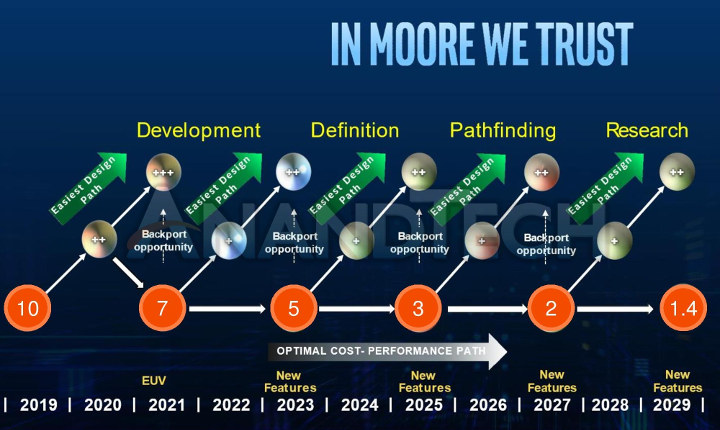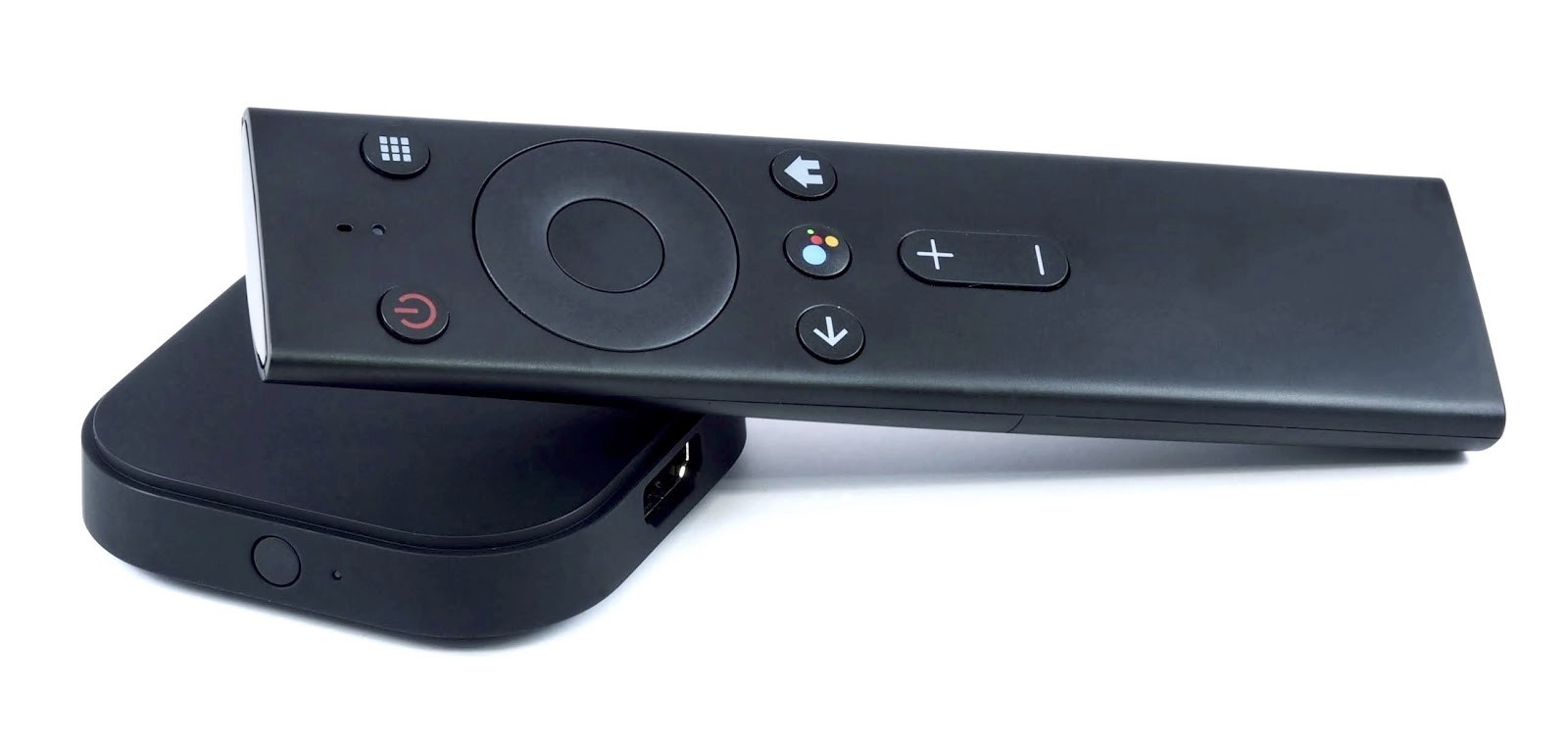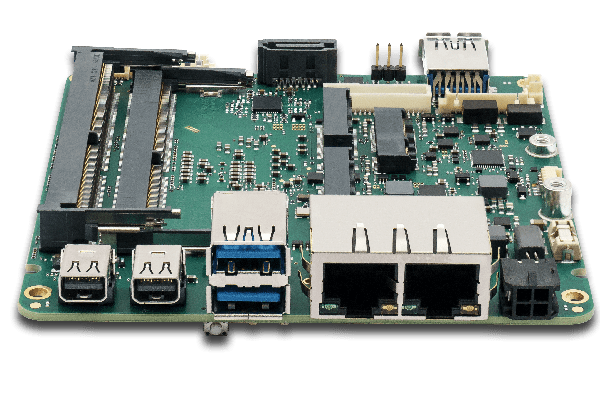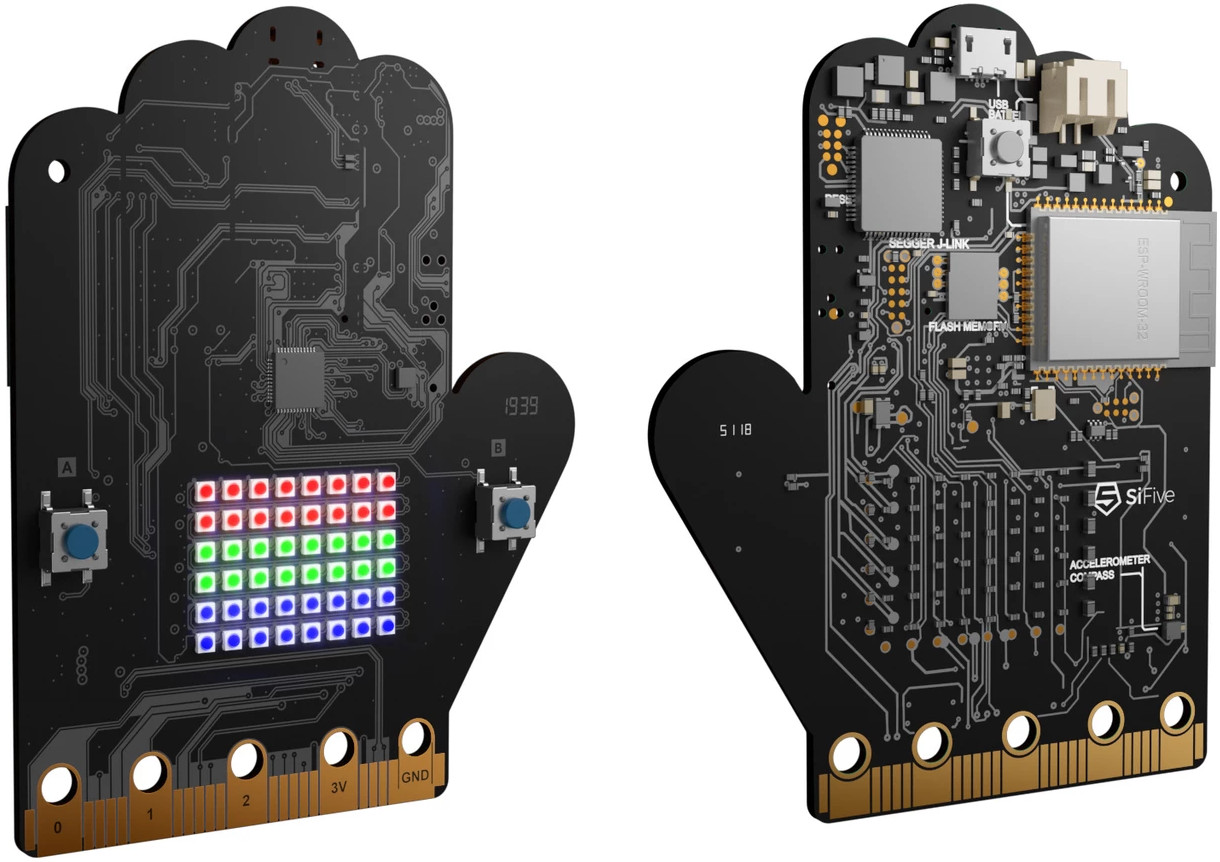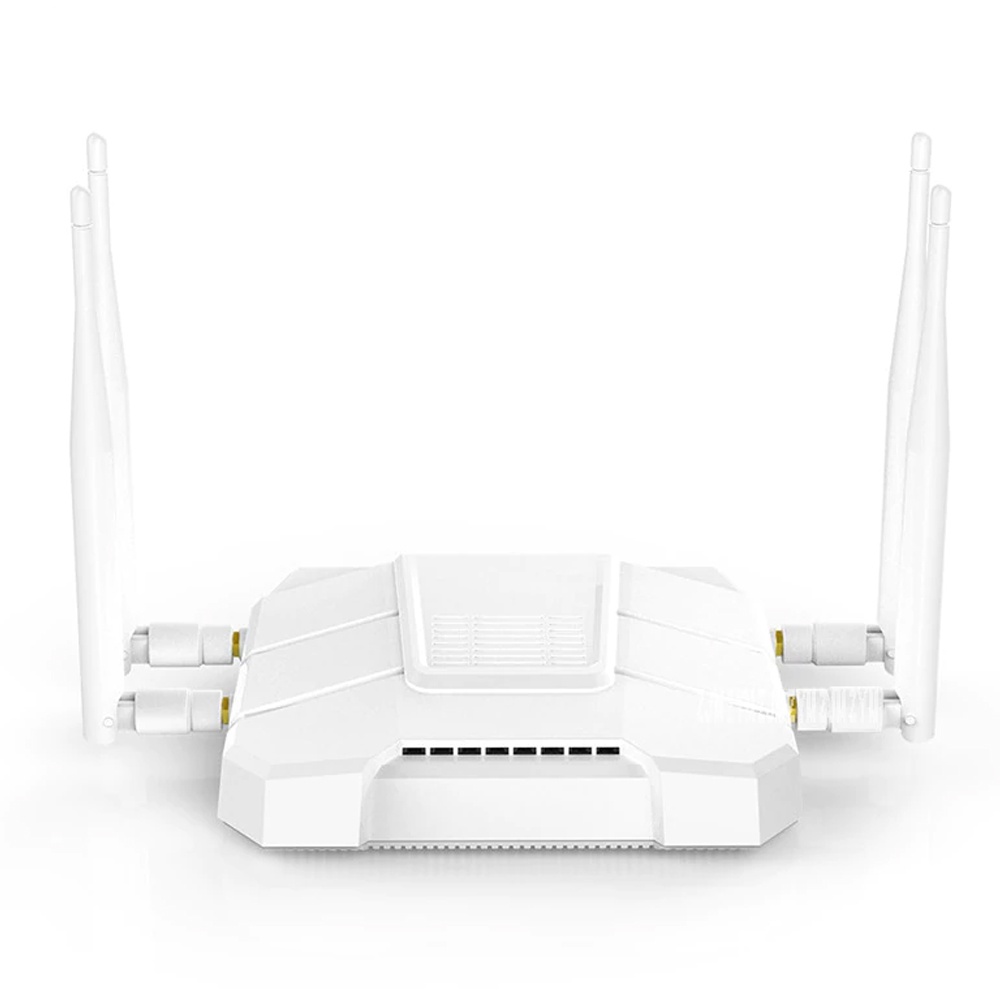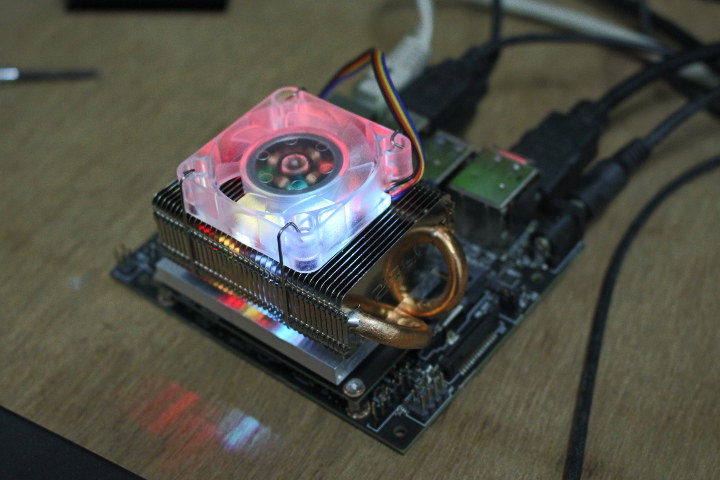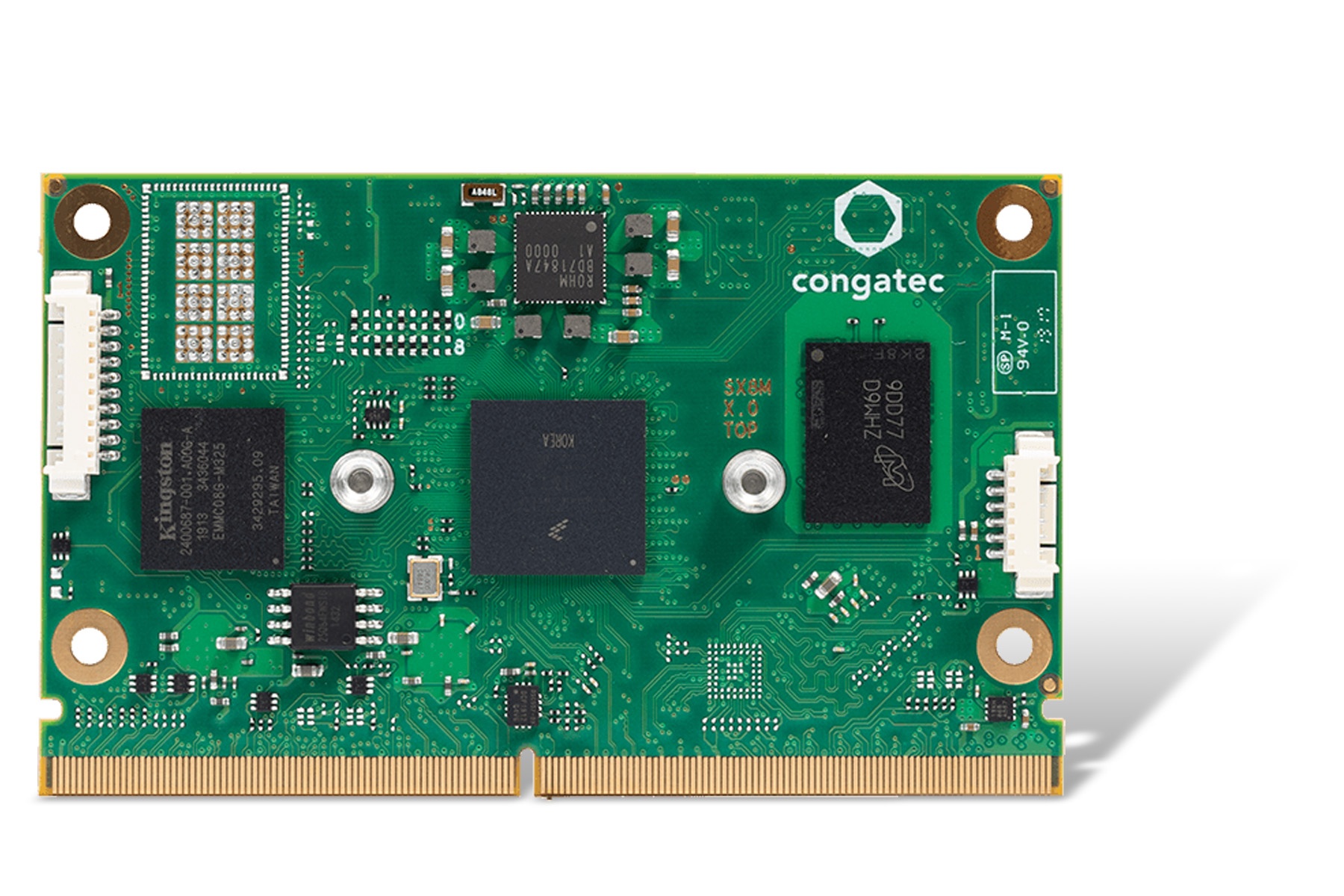Microsemi unveiled PolarFire FPGA + RISC-V SoC about one year ago, but at the time, development was done on a $3,000 platform with SiFive U54 powered HiFive Unleashed board combined with an FPGA add-on board from Microsemi. I’ve now been informed that Microchip has announced its Linux-capable PolarFire FPGA+RISC-V SoC would start shipping in Q3 2020 at the RISC-V summit and that a development kit will be sold for a few hundred dollars. PolarFire SoC FPGA PolarFire SoC FPGA key features and specifications: Mid-Range FPGA optimized for Low Power High-speed serial connectivity with built-in multi-gigabit/multi-protocol transceivers from 250 Mbps to 12.7 Gbps Up to 461k logic elements consisting of a 4-input Look-Up Table (LUT) with a fracture-able D-type flip-flop Up to 31.6 Mb of RAM Power optimized transceivers Up to 1420 18 × 18 multiply-accumulate blocks with hardened pre-adders Integrated dual PCIe for up to ×4 Gen 2 Endpoint […]
Intel Roadmap 2019-2029 – 1.4 nm Processors Expected within 10 Years
A roadmap from a slide by ASML presented at the IEDM conference recently shared on Anandtech shows Intel Roadmap for the next ten years with 7nm manufacturing process expected in 2021, 5nm in 2023, 3nm in 2025, 2nm in 2027, and 1.4nm in 2029. Intel did however contact Anandtech to explain the slide from ASML is a modified version of the Intel slide shown below that does not show actual process nodes, only the dates. I suppose Intel does not want to make any commitments seeing how their 10nm technology suffered delays after delays, and in any case the actual dimensions of the process may vary by that time frame depending on difficulties or new discoveries made. Both slides mention +, ++, and backport opportunities for all new processes. + and ++ are just iterative improvements for the current process, while back- porting is the option to port a process […]
Google ADT-3 is a Developer-Focused TV Box for Android TV on Android 10
Back in 2014, Google killed Google TV and announced Android TV, and as a result, introduced ADT-1, the first developer kit specifically designed for Android TV. Since then ADT-2 was introduced in 2018 in an HDMI stick form factor, and now the company has announced the launch of Android TV on Android 10 together with ADT-3 devkit targetting Android TV app development for Android 10. The “developer kit” just looks like a standard TV box, although It’s really tiny and comes with what looks like a voice remote control. Google did not provide the full specifications, but ADT-3 is equipped with a quad-core Cortex A53 processor coupled with 2GB DDR3 memory, and supports 4Kp60 HDR video playback and output via an HDMI 2.1 output port. That probably means the box is powered by an Amlogic S905X2 processor since few other TV box SoCs combine 4x A53 cores with HDMI 2.1. […]
EEPD Launches AMD Ryzen Embedded NUC Boards & Mini PCs
EEPD SBC Profive follows embedded NUC Standard Electronic Equipment Production and Distribution, also known as EEPD, has just released its latest Embedded SBCs based on the AMD Ryzen Embedded R1000 and V1000 platforms. Respectively they are the SBC Profive NUCR and NUCR both designed for industrial uses. The NUCv has 4 variants with 2 different V1000 series CPUs to choose from, while the NUCR has two R1000 variants. eNUC and Integrated Graphics All variations and types of SBCs and BoxPCs use the embedded NUC standard utilizing the AMD Ryzen embedded platform and series with Radeon Vega Graphics integrated into the system. SBC Profive NUCR specifications AMD Series R1000 Processors – R1606G / R1505G Integrated GPU – AMD Radeon Vega 3 Graphics Up to 32 GB dual-channel DDR4 memory 2x Gigabit Ethernet ports (Intel I210 with IEEE1588) 1x MicroSD card slot 3x M.2 Type B, Type E, Type M sockets M.2 SATA […]
SiFive Learn Inventor is a Wireless RISC-V Development Kit Inspired by BBC Micro:bit
SiFive Learn Inventor is a RISC-V educational board partially inspired by BBC Micro:bit board with the same crocodile clip-friendly edge connector, and an LED matrix. The board is also fully qualified to work with the Amazon FreeRTOS real-time operating system. Shaped in the form of a hand, the board features SiFive FE310 RISC-V processor found in the SiFive HiFive1 board, as well as ESP-WROOM-32 WiFi + Bluetooth module. SiFive Learn Inventor specifications: SoC – SiFive FE310-G003 32-bit RISC-V (RV32IMAFC) processor @ 150 MHz with 64KB of internal SRAM Storage – 512 KB flash “Display” – 6×8 “widescreen” array of RGB LEDs with 262,000 colors each; LEDs can expand off-board onto external arrays via the edge connector Wireless Connectivity – 802.11b/g/n WiFi 4 (2.4GHz) and Bluetooth 4.2 LE via an ESP32 module (ESP-WROOM-32) USB – 1x Micro USB port for power and programming/debugging Expansion A/D Converters (four) accessed via on-board coprocessor […]
FreeMesh WiFi 5 Mesh Network Router Runs OpenWrt
FreeMesh W1326 LTE Router Mesh Network Access FreeMesh has launched an open-source mesh router, the WE1326 LTE FreeMesh Router (included are two nodes) that runs OpenWrt open-source operating system. Open Source and “Hackable” Mesh System FreeMesh enters the mesh market with source code posted on Gitlab, a user-hackable/customizable mesh in other words. FreeMesh uses OpenWrt – the OpenWrt project is a Linux operating system aimed at embedded systems. The focus is on removing the need for a static firmware, where there is only one option for software for the hardware being purchased. The Offerings and Markets The company is targeting the residential market, where most mesh systems are almost double the $150.00 price tag of the FreeMesh. It is reported that there are other ZBT WE826-WD based mesh routers on the market, check out the LinuxGizmos.com article for more information. FreeMesh Specifications FreeMesh Router CPU Dual Core 880MHz MediaTek MT7621AT ROM SPI […]
Testing NVIDIA Jetson Nano Developer Kit with and without Fan
A few weeks ago I received NVIDIA Jetson Nano for review together with 52Pi ICE Tower cooling fan which Seeed Studio included in the package, and yesterday I wrote a getting started guide showing how to setup the board, and play with inference samples leveraging the board’s AI capabilities. I’ll now test the board with the stock heatsink in both 5W and 10W modes, and see if thermal throttling does occur, and then I’ll fit the tower cooling fan to find out if we can extract more performance that way and how much lower the CPU temperature is. Jetson Nano Stress Tests with Stock Heatsink Let’s install SBC-Bench testing utility,
|
1 2 |
wget https://raw.githubusercontent.com/ThomasKaiser/sbc-bench/master/sbc-bench.sh chmod +x sbc-bench.sh |
check it’s properly installed,
|
1 2 3 4 5 |
sudo ./sbc-bench.sh -m Time CPU load %cpu %sys %usr %nice %io %irq Temp 15:05:06: 922MHz 0.05 5% 1% 2% 0% 0% 0% 35.0°C 15:05:11: 922MHz 0.13 3% 1% 1% 0% 0% 0% 35.0°C 15:05:16: 922MHz 0.12 3% 1% 1% 0% 0% 0% 34.8°C |
and run it in 5W mode:
|
1 2 3 4 5 6 7 8 9 10 11 12 13 14 15 16 17 18 19 20 21 22 23 |
sudo nvpmodel -m 1 sudo ./sbc-bench sbc-bench v0.6.9 Memory performance: memcpy: 3685.3 MB/s memset: 8555.4 MB/s 7-zip total scores (3 consecutive runs): 2877,2885,2854 OpenSSL results: type 16 bytes 64 bytes 256 bytes 1024 bytes 8192 bytes 16384 bytes aes-128-cbc 284837.64k 525113.11k 639412.05k 706251.09k 728449.02k 729841.66k aes-128-cbc 284316.13k 525028.93k 634287.70k 704675.84k 728088.58k 728973.31k aes-192-cbc 262002.90k 458230.17k 544725.93k 588999.68k 604075.35k 604607.83k aes-192-cbc 261583.66k 458583.96k 538986.92k 588138.84k 602303.15k 604067.16k aes-256-cbc 247370.60k 405101.35k 466444.29k 501432.32k 512816.47k 513370.79k aes-256-cbc 247650.51k 405270.40k 469783.72k 502266.54k 513187.84k 512977.58k Full results uploaded to http://ix.io/23rg. Please check the log for anomalies (e.g. swapping or throttling happenend) and otherwise share this URL. |
The temperature never went over 44.5°C, and no throttling occurred. tegrastats during 7-zip multi-core test:
|
1 2 3 4 |
CPU [100%@1428,100%@1428,off,off] EMC_FREQ 3%@1600 GR3D_FREQ 0%@76 APE 25 PLL@41.5C CPU@43.5C PMIC@100C GPU@43.5C AO@52.5C thermal@43.5C POM_5V_IN 3348/2567 POM_5V_GPU 0/0 POM_5V_CPU 1549/912 RAM 1211/3956MB (lfb 515x4MB) SWAP 0/1978MB (cached 0MB) IRAM 0/252kB(lfb 252kB) CPU [100%@1428,100%@1428,off,off] EMC_FREQ 3%@1600 GR3D_FREQ 0%@76 APE 25 PLL@41.5C CPU@44C PMIC@100C GPU@43.5C AO@52C thermal@43.5C POM_5V_IN 3348/2568 POM_5V_GPU 0/0 POM_5V_CPU 1549/912 RAM 1239/3956MB (lfb 508x4MB) SWAP 0/1978MB (cached 0MB) IRAM 0/252kB(lfb 252kB) CPU [100%@1428,100%@1428,off,off] EMC_FREQ 3%@1600 GR3D_FREQ 0%@76 APE 25 PLL@41.5C CPU@44C PMIC@100C GPU@43.5C AO@52.5C thermal@43.5C POM_5V_IN 3348/2569 POM_5V_GPU 0/0 POM_5V_CPU 1549/913 RAM 1265/3956MB (lfb 502x4MB) SWAP 0/1978MB (cached 0MB) IRAM 0/252kB(lfb 252kB) CPU [100%@1428,100%@1428,off,off] EMC_FREQ 3%@1600 GR3D_FREQ 0%@76 APE 25 PLL@41.5C CPU@43.5C PMIC@100C GPU@43.5C AO@52.5C thermal@43.5C POM_5V_IN 3348/2571 POM_5V_GPU 0/0 POM_5V_CPU 1510/914 |
Only two Cortex-A57 cores are used even under load, and power […]
Congatec Conga-SMX8-Nano SMARC 2.0 CoM Features NXP i.MX 8M Nano Processor
Congatec Announces Ultra-Low-Power SMARC 2.0 CoM Congatec has come out with a new CoM, the Conga-SMX8-Nano that carries up to 4x ARM Cortex-A53 and 1x Cortex-M7 cores with a full spectrum of options. The SMARC 2.0 module can meet ultra-low-power requirements, offers low cost, as well as high-level performance. Background Information Background on NXP i.MX 8M Nano processors and modules have been reported in our report about iWave’s iW-RainboW-G34M-SM SoM and the introduction of the i.MX 8M Nano ARM Cortex-A53 and M7 processor to the market. A Board for the Industry The intention here is to develop a board that has high performance, ultra-low power requirements and can reach high volumes at low cost. The modules are scalable to the conga-SMX-8-Mini CoM, with options for a multitude of setups across types. Example Uses for conga-SMX8-Nano The company offers the example of a complex medical user interface that engineers might want […]



